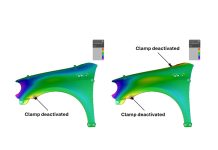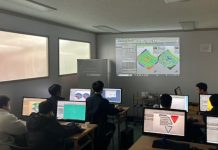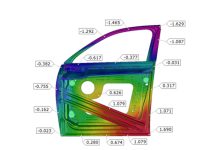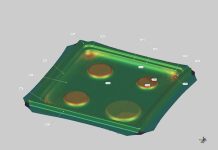There is a long history of people promoting the idea of simultaneous engineering of product and processes. However, in many cases, the term “simultaneous engineering” is generally a euphemism for early hand-off (or outright throwing over the wall) of preliminary engineering data. Some sheet metal design and engineering organizations have implemented early release of sheet metal design data to specialized advanced feasibility teams or groups within the product organization, with the aim of eliminating potential rejection of parts by manufacturing; however, such third-party consultation still has the potential to waste time, as frequent hand-offs of data between personnel will usually result in waiting and bottlenecks.

When feasibility studies are performed by other organizations, change requests can come late in the process chain
After the preliminary release, there can be an indeterminate waiting period, followed by a request from the advanced feasibility group to alter the product design. In many cases, the alteration of the product design seems to be a minor change to the manufacturing specialists responsible for the feasibility assessment. The manufacturing specialists will suggest an increase to a fillet radius or increase to a wall angle, to avoid a forming issue like splitting or wrinkling without significant alteration to an intended process to manufacture. However, to the product development group, such changes, when unforeseen, can have significant, perhaps even crippling costs. Increasing radii often impacts not only that particular sheet metal stamping, but also componentry within the assembly, product performance, and intent for scalability of product within a global manufacturing plan.
If the product development group was able to anticipate the potential for forming issues prior to the release of the preliminary data, they could potentially avoid committing to unfeasible geometry within the assembly, postpone product performance CAE, and escalate the geometry for advanced manufacturing feasibility at an earlier stage, when costs avoidance is still possible.

Using feasibility assessment tools at the design source, can identify issues earlier and be resolved without wasted time
Additionally, when the suggestion for product change comes back to the product development group, they still have to design alternative geometry for the component as well as any affected products adjacent to the part with the forming issue. In many organizations, once an alternative geometry is designed in CAD, they again release the data for another feasibility assessment. Often, the changes are the absolute minimum interpretation of the recommended changes (e.g., one additional degree of draft angle, one millimeter increase for forming radii). When analyzed again, the changes might still cause forming issues. The cycle begins again; release to advanced feasibility, wait for results, amend product design if still unfeasible, and repeat.
An alternative to this cycle would be to enable the product development designer or engineer to perform their own preliminary feasibility assessments. With minimal training and preparation, they can potentially weed out unmanufacturable product design geometries or recognize the need to escalate to manufacturing advanced feasibility issues earlier, prior to finalizing other aspects of the design like packaging, seal, assembly, or paint processes.
Escalation of forming issues and issue resolution
Forming issue escalation might be as simple as a telephone call, web conference, or review of forming assessment results on a monitor. Manufacturing engineering specialists who might later conduct the advanced feasibility analysis could see potential for geometry modifications that would resolve the potential forming issue; or they might recognize that the manufacturing process could address the issue without significant change to product geometry. During this escalation interaction, the manufacturing engineer could recommend that advance feasibility must start in earnest before the part is released to identify if the part can ever be made, or suggest modest product changes.

Original product design with geometry related forming issues identified, product modifications to geometry show resolution is possible
If the part could be redesigned rapidly and again assessed for effectiveness in resolving the forming issues, the repetitive, time-consuming, and wasteful cycle of release-reject-recommend-release could be avoided altogether. However, making design changes like increasing fillets or opening wall angles is often easier said than done. Part modifications, such as decreasing the depth of a pocket or increasing the plan view radius of a feature, is something that in CAD could result in hours of additional modeling — only to demonstrate that the changes do not significantly reduce the forming severity.
This preliminary forming assessment does not eliminate or replace advanced feasibility and Draw-OP engineering, but it can help streamline the overall process and eliminate several iterations of product change requests. If product engineers were allowed to perform geometry-based forming checks, the advanced feasibility step should be completed more smoothly, with fewer product-geometry-based forming issues, leading to more focus on the stamping process plan. This would reduce time to market, while assuring better quality of engineering inputs into other aspects of the vehicle design.
Using the modify functionality of AutoForm-StampingAdviser, a product development engineer can direct model product changes and evaluate for improvement in forming behavior. With access to their own forming assessments, product engineers can iterate and evaluate using different product concepts without the burden of CAD modeling or the implications to PLM integrity, until a reasonable geometry is identified. They may even pass on the modified geometry to their manufacturing counterparts for validation, employing the more detailed analysis used for advanced feasibility assessments, before committing any of the changes to the CAD models.














It’s interesting how technology has influenced how something as simple as working with sheet metal. I will have to see if the project that I have been looking to make can be designed on the computer to make sure that everything is where I want them to be. Hopefully talking to a professional that works with the system can get me a more solid plan.
[…] derived from several sources—such as an expanded punch opening, minimum blank output from inverse one-step finite element analysis (FEA), or arbitrarily defined […]
A very enlightening write-up on how simultaneous engineering has been incorporated into sheet metal part manufacturing. Does this work for Aluminum sheets also?
An extended material library comes along with the AutoForm package – including a variety of Al-materials. So one is prepared with the most popular alloys already from the beginning. In case that this is not yet enough, one can create its own material files in our included AutoForm-MaterialGenerator – based on literature data or conducted material and formability tests. We offer sophisticated scientific approaches for the description of any material behavior – including failure. This explicitly includes Al-materials. We also refer to successfully performing projects related to warm- and hotforming of Al-alloy sheet metal.
Michael Duering.